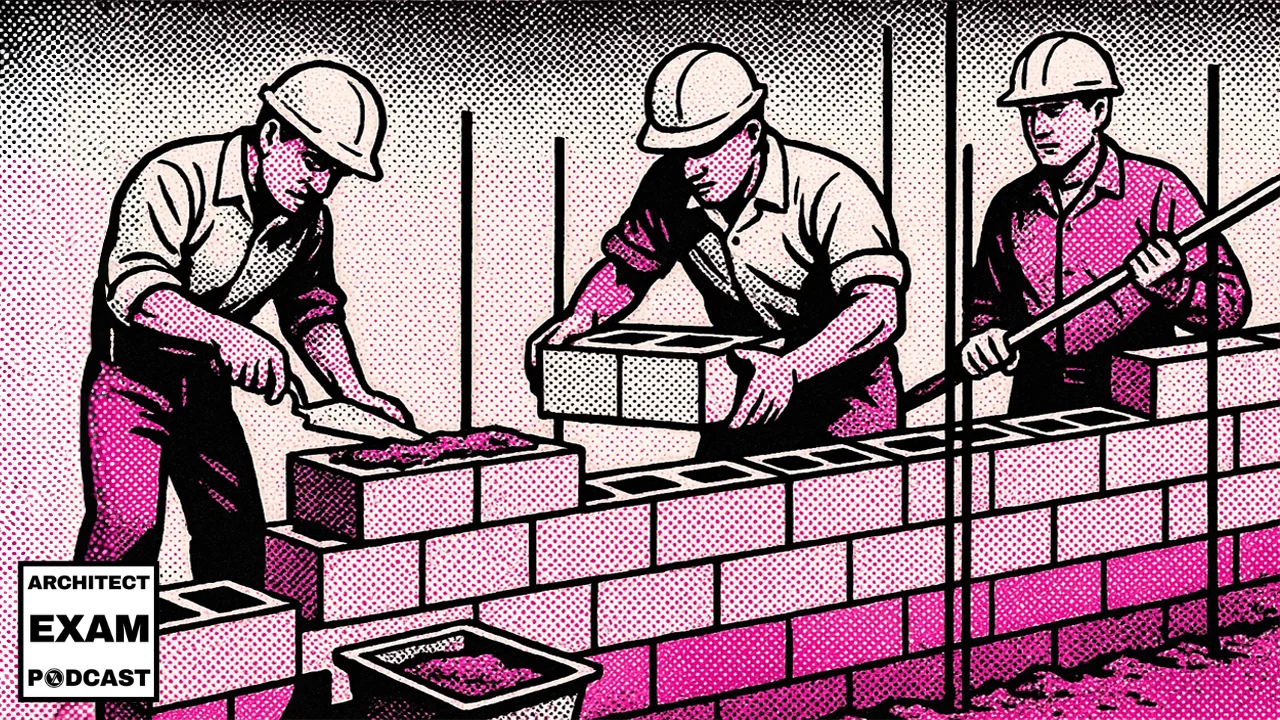Construction types are fundamental building classifications that determine everything from fire resistance to allowable heights and materials. This guide breaks down all five types of building construction as defined in the International Building Code (IBC), explaining their key differences and practical applications in real-world building design.
This podcast is also available on YouTube, Spotify, and Apple Podcasts
What Are Building Construction Types?
Essentially, they are classifications that categorize buildings based on their fire resistance and the materials used in their structural elements. Specifically, the International Building Code (IBC) defines the 5 types of construction, labeled with Roman numerals I through V. As a result, Type 1 construction has the highest fire resistance rating, making it the safest, while conversely, Type 5 construction (often written as Type V construction) has the lowest fire resistance.
Think of it like choosing the right material for different products. We don’t make umbrellas out of paper because they’d fall apart in the rain. And we don’t build high-rises out of wood studs because they wouldn’t provide enough fire protection for all those people.
They are all about matching the building’s fire safety to its size, height, and use.
And here’s why this matters for the ARE and real practice: selecting the wrong construction type can lead to:
- Projects that violate code requirements
- Unexpected budget increases
- Designs that simply aren’t safe
For instance, I once worked with a client who wanted to add three stories to their existing one-story retail building. However, the problem was that it was built as Type V-B, which has strict height limitations. Consequently, we either needed to:
- First, change our design
- Alternatively, upgrade to a higher construction type (which meant major reconstruction)
- Or finally, find another solution, such as creating a separate structure
Understanding this concept saves you from these kinds of expensive surprises.
How Construction Types Affect Building Design
They can influence almost every aspect of building design:
- Building height and area are directly tied to construction type. A Type I building can reach the sky – think skyscrapers – while Type V typically maxes out at 3-4 stories in most cases.
- Cost implications are huge. Generally, each step up in construction type means higher costs. Type V wood framing might cost $200 per square foot, while Type I could easily be double that.
- Material selection is obviously constrained by type. Type I and II require noncombustible materials, while Types III through V allow varying degrees of combustible materials like wood.
- Design flexibility changes too. Different structural systems come with different spanning capabilities and space configurations.
To illustrate this point, let me paint a picture: imagine a 5,000 square foot building. Initially, as Type V, it might be wood-framed with 2×6 walls and conventional trusses. In contrast, as Type II, it would have steel columns and beams with metal decking. Furthermore, as Type I, it would have heavily protected structural elements, perhaps concrete columns with additional fireproofing.
Same size, completely different buildings.
Tour of The Five Types of Building Construction
Now let’s walk through each of the 5 types. Understanding these classifications is a key part of quality assurance activities. I like to use analogies to help remember their characteristics and understand the different types of buildings you’ll encounter.
Type 1 Construction: Fire-Resistive
I like to think of Type 1 as the fortress of building types.
Type 1 buildings are designed to withstand fire for extended periods – typically 2-3 hours for structural elements. Therefore, they’re built using concrete, protected steel, and other non-combustible materials that provide the highest level of fire protection. Additionally, these materials must meet rigorous testing standards.
Where do you see Type I? High-rise buildings, hospitals, and large civic structures. Think of a skyscraper downtown – it’s designed to contain a fire and stay standing for hours, giving people time to evacuate and firefighters time to respond.
Type I has two subtypes:
- Type I-A is the most stringent, with 3-hour structural frame ratings
- Type I-B is slightly less with 2-hour ratings
This is your most expensive construction type, but it allows virtually unlimited height and area.
Type 2 Construction: Non-Combustible
Type 2 is the middle ground of building classifications.
These buildings use non-combustible materials like steel, concrete, and masonry, but with less fire protection than Type 1. To help understand this concept, picture a steel file cabinet – it won’t burn, but nevertheless, it might warp or collapse in intense heat. As a result, Type 2 balances fire resistance with practical construction costs while still providing adequate safety.
Where do you see Type II? Schools, warehouses, big-box retail stores. Many commercial buildings are Type II because it balances cost and safety.
Type II also has two subtypes:
- Type II-A provides 1-hour fire resistance
- Type II-B has little to no required fire protection on structural elements
Think of II-B like an exposed steel frame warehouse – noncombustible but not highly protected.
Type 3 Construction: Ordinary
Type 3 is sometimes called “ordinary construction” – I think of it as the mullet of building types: business in the front, party in the back.
It features non-combustible exterior walls (usually masonry or concrete) but simultaneously allows combustible (usually wood) interior elements. Consequently, this hybrid approach makes Type 3 a popular choice for many mid-sized buildings since it combines durability with economy.
Where do you see Type III? Old main street buildings, modern mid-rise apartments, and mixed-use developments. That brick building downtown with wood floors? Probably Type III.
Again, we have two subtypes:
- Type III-A requires 1-hour rated interior elements
- Type III-B allows non-rated interior construction
This construction type is popular for 4-5 story apartments because it’s more economical than Types I or II while still allowing decent height and area.
Type 4 Construction: Heavy Timber
Type 4 is the gentle giant of wood building classifications.
The distinctive feature of Type 4 construction is the use of large dimensional lumber – think big wooden columns, beams, and plank floors. Interestingly, these massive wood members char on the outside during a fire but retain structural integrity longer than small dimension lumber. As a result, this gives Type 4 buildings surprisingly good fire resistance despite using combustible materials. Moreover, this charring effect actually creates a natural protective layer.
A critical difference between Type III and Type IV construction is the treatment of concealed spaces. Type IV heavy timber construction prohibits hidden voids between structural components, while Type III ordinary construction allows concealed spaces within its combustible interior framework.
Where do you see Type IV? Historically in factories, mills, and churches. Today, in modern “mass timber” buildings, breweries, and trendy offices with exposed wood structure.
Modern heavy timber construction is primarily valued for its distinctive aesthetic qualities, creating warm, visually striking spaces in contemporary architecture. This explains its popularity in breweries, trendy offices, and public buildings where exposed structural elements become a key design feature.
Type IV traditionally didn’t have subtypes, but newer codes have added some variations for taller mass timber buildings.
Heavy timber is experiencing a renaissance in modern architecture due to sustainability benefits and the warm aesthetic of exposed wood structure.
Type 5 Construction: Wood-Frame
Finally, Type 5 (Type V construction) is the most common building classification for homes and small buildings.
Type 5 uses conventional light wood frame construction – primarily 2×4 or 2×6 studs, wood joists, and plywood sheathing. Obviously, it’s what most houses are built from and consequently represents the most economical building type in many regions. Despite its limitations, it remains incredibly versatile.
Where do you see Type V? Single-family homes, townhouses, small apartment buildings, and small commercial structures. Basically, most buildings under 3 stories.
Type V has two important subtypes:
- Type V-A (protected) requires 1-hour fire-rated construction for structural elements
- Type V-B (unprotected) has no fire-resistance requirements for the structure
This is your most economical type, but with the highest fire risk and the strictest limitations on height and area.
What is Type A and Type B Construction?
You’ve probably noticed most types have A and B variations. Here’s the simple version:
“A” means additional fire protection. It’s like adding a raincoat to your outfit.
“B” means basic protection (or sometimes none). Just the standard clothes, no raincoat.
This A/B distinction has real implications:
- Type I-A vs I-B: That extra hour of fire protection means you can often build several stories taller
- Type II-A vs II-B: Adding 1-hour protection to otherwise noncombustible materials
- Type III-A vs III-B: Making the wood interior elements more fire-resistant
- Type V-A vs V-B: The difference between protected and unprotected wood frame
The A subtypes cost more but allow larger/taller buildings than their B counterparts.
Real-World Applications
Let’s talk about how these types play out in real buildings:
Single-family homes are almost always Type V-B because it’s economical, and the smaller building size means less risk.
Mid-rise apartments often use Type V-A (with fire-rated assemblies) or Type III-A (noncombustible exterior walls) because they balance cost with needed fire protection for multiple units.
High-rise offices require Type I because of their height and occupant load. The code simply doesn’t allow tall buildings in combustible construction.
One trend you might have heard about is the “five-over-one” or “podium building” – a concrete first floor (Type I) with five stories of wood frame (Type V) above. This creative approach maximizes the economic benefits of wood construction while meeting code requirements.
Construction Types and Building Height/Area
There’s a direct relationship between construction type and how big your building can be:
The more fire-resistant the construction, the bigger and taller the building can be.
Think about it logically – a more fire-resistant building gives people more time to evacuate, therefore the code allows more stories and larger floor plates. Additionally, this relationship follows a clear pattern throughout the building code.
The IBC has detailed tables showing the maximum height (in feet and stories) and the maximum area per floor for each construction type and occupancy combination.
As a general rule:
- Type I has essentially unlimited height and area
- Type II allows moderate height (4-6 stories typically)
- Type III/IV allow modest height (3-5 stories usually)
- Type V is the most limited (typically 3 stories or less)
Adding sprinklers can increase these allowable heights and areas significantly – sometimes by 300% for area! This is why almost all commercial buildings have sprinklers – they’re a cost-effective way to gain more design flexibility.
Why Construction Types Matter for the ARE
This topic appear across multiple divisions of the Architect Registration Exam (ARE), making them a critical concept to understand thoroughly:
In Programming & Analysis (PA), you’ll need to understand construction types when conducting code analyses to determine project parameters. When evaluating site constraints or building requirements, knowing which type is appropriate helps you establish accurate height and area limitations early in the design process. This foundational knowledge is tested in the PA exam’s code and regulations section.
For Project Planning & Design (PPD) and Project Development & Documentation (PDD), construction types directly influence material selection, structural systems, and fire protection strategies. As you develop schematic designs and construction documents, you’ll need to specify appropriate assemblies that meet the requirements of your chosen type. These decisions impact everything from wall assemblies to structural connections.
During Construction & Evaluation (CE), understanding construction types is crucial when:
- Verifying that installed materials match the specified construction type requirements
- Evaluating substitution requests to ensure they maintain required fire ratings
- Conducting inspections of fire-rated assemblies during construction
- Coordinating with contractors regarding proper installation of fire-stopping and other protection measures
- Reviewing testing and special inspection reports for fire-rated assemblies
This knowledge helps ensure that what gets built actually meets the code requirements established during the design phase, which is a key focus of the CE division of the ARE.
We’ve written dozens of ARE practice questions about how construction types influence an architect’s decision making in our ARE 101 courses because it’s such a fundamental concept for understanding building codes and passing the exam.
Common Misconceptions
Before we wrap up, let me clear up some common misconceptions that I frequently see trip up ARE candidates. Recognizing these errors will help you avoid making similar mistakes:
“Brick veneer makes a building Type III.” False! If you have brick veneer over wood framing, it’s still Type V. For Type III, the exterior wall structure itself must be noncombustible.
“Steel doesn’t burn, so it’s completely safe in fire.” Not exactly. Unprotected steel (Type II-B) can warp and fail quickly in high heat. That’s why we add protection in higher types.
“Heavy timber (Type IV) burns easily because it’s wood.” Actually, large timber members char on the outside while maintaining structural integrity inside – sometimes performing better than unprotected steel in fires.
“Construction type is determined by the best material used.” Nope, it’s determined by the most combustible/least protected structural elements. One wood structural element in an otherwise concrete building makes it a combustible type.
“If I put sprinklers in, I can build any type anywhere.” Sprinklers help increase allowable heights and areas, but they don’t change the fundamental construction type or eliminate all limitations.
Mastering Construction Types for ARE 5.0 Success
So, let’s recap what we’ve covered about the 5 types of building construction:
- Construction types (I-V) classify buildings based on fire resistance and materials used
- Type 1 construction (fire-resistive) provides the most protection but costs the most
- Type 5 construction (wood frame) is the most economical but has the highest fire risk
- The more fire-resistant the construction type, the taller and larger the building can be
- The A/B subtypes indicate higher or lower levels of fire protection within each construction type
Understanding construction types helps you design safer buildings, pass the ARE, and avoid costly mistakes in practice. This knowledge is crucial across multiple ARE divisions, including Programming & Analysis, Project Planning & Design, Project Development & Documentation, and Construction & Evaluation.
If you’re preparing for the ARE, I highly recommend checking out our Building Codes 101 course. This comprehensive course includes almost 5 hours of building code content specifically for the ARE, along with 180 practice questions and 175 flashcards to really cement your understanding.
What makes this course special is that the practice questions come with thorough explanations that don’t just tell you the right answer – they actually teach the concept to you. All the questions and flashcards are strategically organized into beginner, intermediate, and advanced levels, so they continue to challenge you as your knowledge grows.
Next time you’re walking around your city, try to identify the construction types of different buildings. It’s a great way to cement these concepts!



